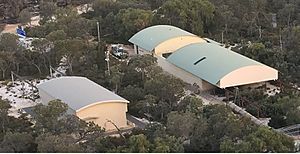GDC Observatory facts for kids
The GDC Observatory is a special place where people can explore and learn about the night sky. It's an observatory, which means it has powerful telescopes to look at stars, planets, and galaxies. The observatory is located in Gingin, Western Australia, a town known for its clear skies. It's part of a larger area called the Gingin Gravity Precinct. The GDC Observatory welcomes visitors regularly, offering exciting opportunities to see the wonders of space.
Southern Cross Cosmos Centre: Your Gateway to the Stars
The GDC Observatory is found inside a building called the Southern Cross Cosmos Centre. This building was specially built for stargazing and opened its doors in 2001. It has a unique roof that can slide open, revealing the night sky above.
Inside the centre, there are five different telescopes that visitors can use during special viewing nights. These telescopes help you see distant objects in amazing detail. The largest telescope there is called "Brodie-Hall." It's a very big telescope, about 25-inch (640 mm) across, which means it can gather a lot of light and show you faint objects. This impressive telescope was kindly given to the observatory by Laurence and Jean Brodie-Hall.
Right next door to the Southern Cross Cosmos Centre is another important telescope called the Zadko telescope. This telescope is operated by the University of Western Australia and is used for important scientific research, helping scientists discover new things about the universe.
See also
- List of astronomical observatories
- List of astronomical societies
- Lists of telescopes


